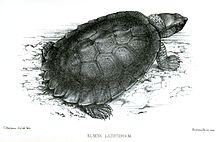- Saw-shelled turtle
-
Saw-shelled turtle (Myuchelys latisternum) 
Photo by Craig Latta Conservation status Scientific classification Kingdom: Animalia Phylum: Chordata Class: Reptilia Order: Testudines Family: Chelidae Subfamily: Chelodininae Genus: Myuchelys Species: M. latisternum Binomial name Myuchelys latisternum
(Gray, 1867)[1]The Saw-shelled turtle or Myuchelys latisternum, is a species of turtle in the Chelidae family. It is endemic to Australia, ranging along rivers and streams and connected swamps and lagoons from coastal Cape York Peninsula to northern New South Wales. They are thought to have been introduced to Lake Eacham in the Atherton Tablelands. Other common English names are: Serrated snapping turtle, or Common sawshell turtle.[2][3]
Contents
Description
The female is considerably larger than the male with a carapace up to 28 cm long compared to the males which rarely get bigger than about 18 cm. The carapace is roughly oval and broad at the rear.[2][3] They are not usually aggressive, but can bite fiercely. They can also emit a strong smell.[3]
The shell has marginal serrations which are the reason for its common name, the "Saw-shelled turtle". It retains some of these serrations throughout its life. "The head shield extends down the side of the head to just above the tympanum, and the top of the neck has prominent pointed tubercules (many of these with an apical sensory pit)."[3]
The carapace is mainly brown to dark brown, commonly with some some dark blotches. The plastron (underside) is yellowish. The head is large with a projecting snout and a horny plate on the top. The neck can fold sideways. The feet are webbed and also clawed. Hatchlings have serrated hind legs which become smooth as they mature.[4]
Nomenclatural History
Myuchelys latisternum (Gray, 1867) (Common sawshell turtle)
- 1867 Elseya latisternum Gray, 1867, holotype, BMNH 1947.3.4.13, from North Australia.[1]
- 1871 Euchelymys spinosa Gray, 1871, holotype, BMNH 1946.1.22.77, from North Australia. Synonymy
follows that of Gray (1872a) and Boulenger (1889).[5]
- 2009 Myuchelys latisternum — Thomson & Georges, 2009.[6] First use of combination.
The combination Wollumbinia latisternum (Gray, 1867) Wells, 2007, was declared unpublished and hence unavailable for use by Georges & Thomson, 2010.[7]
Nesting
The females nest from September to December. They can have three to four clutches in one season of between 9 and 36 eggs which hatch before winter in about 60 days, with the incubation period shortened in southern regions.[3] The eggs are variably described as either, "hard-shelled (34 X 22 mm)",[2] or as small and "flexible-shelled".[3]
Feeding habits
The Saw-shelled turtle is carnivorous and feeds on fish, tadpoles, frogs, aquatic insects and is one of the few native Australian animals successful in preying on the introduced and very poisonous Cane Toads (Bufo marinus).[2] Toads too large to swallow whole are first shredded with their front claws.[3]
References
- ^ a b Gray, J.E. 1867. Description of a new Australian tortoise. Annals and Magazine of Natural History. 3(20):43-45
- ^ a b c d Ryan, Michelle, General Editor. (2000). Wildlife of Tropical North Queensland: Cooktown to Mackay. Queensland Museum. ISBN 0-7242-9349-3.
- ^ a b c d e f g Ehmann, Harold (1992). Encyclopedia of Australian Animals: Reptiles. Angus&Robertson. ISBN 0 207 17379 6 (Reptiles)
- ^ Elseya latisternum
- ^ Gray, J.E. 1871. On Euchelymys a new genus and two new species of Australian freshwater tortoises. Annals and Magazine of Natural History. (4)8:117-118.
- ^ Thomson, S. & Georges, A. (2009) Myuchelys gen. nov. —a new genus for Elseya latisternum and related forms of Australian freshwater turtle (Testudines: Pleurodira: Chelidae) Zootaxa 2053: 32–42.
- ^ Georges, A. & Thomson, S. 2010. Diversity of Australasian freshwater turtles, with an annotated synonymy and keys to species. Zootaxa 2496: 1–37.
External links
Side-necked turtle species Kingdom: Animalia · Phylum: Chordata · Class: Reptilia · Subclass: Anapsida · Order: Testudines · Suborder: Pleurodira Family Chelidae Chelodininae Chelodina canni · Chelodina longicollis · Chelodina mccordi · Chelodina novaeguineae · Chelodina reimanni · Chelodina steindachneri · Chelodina burrungandjii · Chelodina expansa · Chelodina parkeri · Chelodina rugosa · Chelodina collieiEmydura australis · Emydura macquarii · Emydura signata · Emydura subglobosa · Emydura tanybaraga · Emydura victoriaeMyuchelys latisternum · Myuchelys georgesi · Myuchelys purvisi · Myuchelys belli · Myuchelys novaeguineaePseudemyduraPseudemydura umbrinaRheodytesRheodytes leukopsChelidinae ChelusChelus fimbriatus (Mata mata)Mesoclemmys dahli · Mesoclemmys gibba · Mesoclemmys heliostemma · Mesoclemmys hogei · Mesoclemmys nasuta · Mesoclemmys perplexa · Mesoclemmys raniceps · Mesoclemmys tuberculata · Mesoclemmys vanderhaegei · Mesoclemmys zuliaePhrynops geoffroanus · Phrynops hilarii · Phrynops tuberosus · Phrynops williamsiRhinemysRhinemys_rufipesHydromedusinae Superfamily Pelomedusoidea Pelomedusinae PelomedusaPelomedusa subrufaPelusios adansonii · Pelusios bechuanicus · Pelusios broadleyi · Pelusios carinatus · Pelusios castanaeus · Pelusios castanoides · Pelusios chapini · Pelusios cupulatta · Pelusios gabonensis · Pelusios marani · Pelusios nanus · Pelusios niger · Pelusios rhodesianus · Pelusios sinuatus · Pelusios subniger · Pelusios upembae · Pelusios williamsiPodocnemidinae ErymnochelysErymnochelys madagascariensisPeltocephalusPeltocephalus dumerilianusPodocnemis expansa · Podocnemis unifilis · Podocnemis erythrocephala · Podocnemis lewyana · Podocnemis sextuberculata · Podocnemis vogliCategories:- IUCN Red List data deficient species
- Myuchelys
- Reptiles of Australia
Wikimedia Foundation. 2010.


